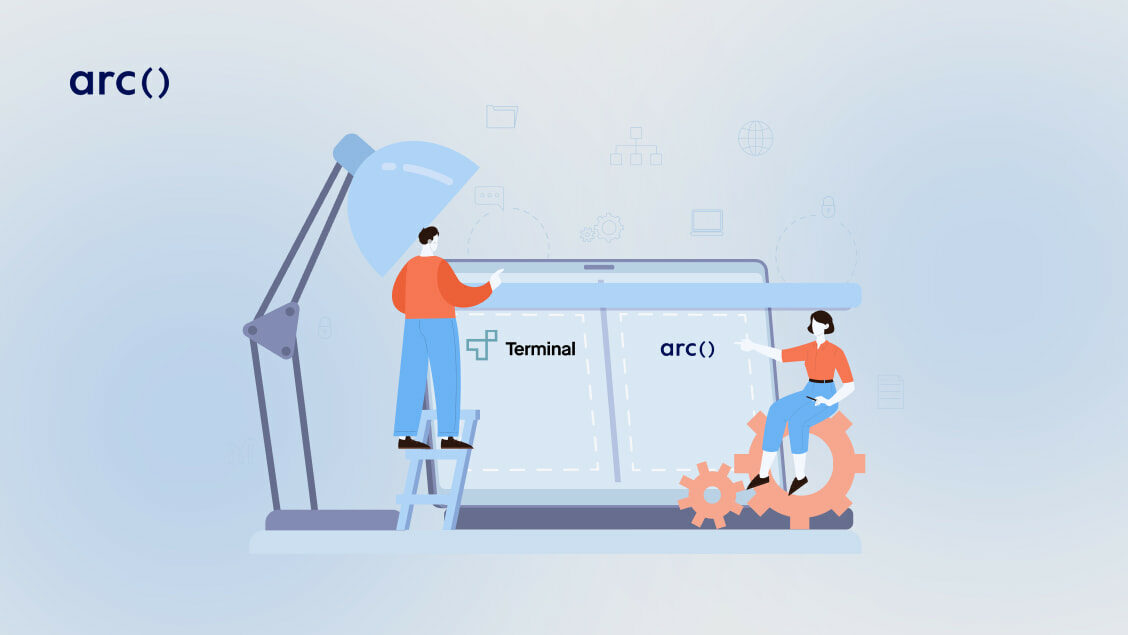Terminal.io is a talent platform that offers both a hiring marketplace as well as team management services specifically for companies looking to hire software engineers from North and South America.
While Arc can help you find a permanent team member (as well as contract developers) from anywhere in the world, Terminal.io primarily hires engineers from Canada, Mexico, Colombia, and Chile.
Arc and Terminal are both platforms that help you hire full-time software developers for your team, but which is a better fit for your needs?
To help you choose between Arc or Terminal.io for your next hire, we’re going to look at these factors:
- Project Types Supported
- Vetting Process
- Hiring Process
- Cost to Hire
- Trial Period and Quality Guarantee
Looking for top talent fast? See how Arc can help you:
⚡️ Find developers, designers, marketers, and more
⚡️ Freelance or full-time remote + fully vetted
⚡️ Save up to 80% with global hires
Hire top talent with Arc risk-free →
About Arc and Terminal
Arc on Hiring Engineers
We believe you don’t have to live in a tech hub to do great work. Arc is a remote career platform that takes the friction out of both sides of the hiring equation. We help developers prepare for and find remote jobs, and simplify the process for organizations hiring remotely. Organizations no longer have to hire only from a small talent pool when there’s great talent the world over.
Terminal.io on Hiring Engineers
Terminal is pushing the world of work forward by bringing career opportunities to premier tech talent globally. We believe in helping companies reach across geographical barriers to find and engage qualified tech professionals, wherever they may be located. We provide services and infrastructure in a comprehensive solution to help our partner companies scale with ease while also offering meaningful professional opportunities throughout the world.
Project Types: Arc vs Terminal.io
Arc Project Types
Arc can help you find pre-vetted developers for both permanent and contract roles, for projects where you just need that extra burst of manpower. Arc can also place you with mid-level to senior-level remote developers from all over the world — not just Silicon Valley.
Terminal.io Project Types
Terminal io provides primarily permanent, full-time hires from Canada, Colombia, Costa Rica, Chile, Mexico, Spain, and Poland.
Read More: 40+ Best Upwork Alternatives & Freelance Websites for Your Next Project
Vetting process: Arc vs Terminal.io
Arc Vetting Process
Arc developers go through a rigorous and transparent vetting process before they are featured to hiring managers. We want employers to feel confident they are saving time by meeting candidates who are already qualified.
Arc vets developers for communication and technical skills:
Communication skills verification
Our talent partners first screen a candidate’s profile for relevant training and experience. If it checks out, we then assess English language proficiency and communication skills. This is done in one of two ways:
- Through live 1:1 video calls with our internal recruiting experts, or
- Through an asynchronous video interview.
Technical vetting process
Next, developers will then have a technical assessment to test their skills and knowledge in programming languages, algorithms, domain specialization, and frameworks. We also test their ability to translate these programming skills into business value.
To accommodate varying learning styles and preferences, technical vetting can be done in one of two ways:
- A rigorous Arc-exclusive coding challenge created by in-house developers and reviewed by our global community of experts, or
- A live, online technical interview with a senior developer partner from a top tech company consisting of live pair programming, broad technical interview questions, and a deep dive into the developer’s specific domain.
Terminal.io Vetting Process
Terminal’s website mentions that they help you recruit, vet, and hire talent, but it does not go into detail about their vetting process.
Per their engineer FAQ, the vetting process includes a pre-screen for role fit. Terminal io candidates create an account and complete a profile, get matched to roles that Terminal believes is a good fit, apply, and are notified if they move forward to a pre-screen with someone from Terminal, where they’re introduced to your company for interviews.
Read More: Hiring Developers Online: Freelance vs Recruitment Agencies vs In-House
Hiring Process: Arc vs Terminal.io
Arc Hiring Process
Arc offers a wide range of skilled developers to assist businesses in hiring remotely for their open roles. If you need a full-time developer, Arc can help you find the ideal candidate about four times faster than the traditional hiring process, which usually takes around two months. With Arc, you’ll get a personalized list of remote developers who are ready to be hired. Once you’ve reviewed the list, you can directly send interview invitations to the developers you’re interested in.
If you haven’t found the perfect developer yet, don’t worry. Arc offers a new list of remote developers every two weeks to help you keep your search fresh and updated.
Arc has also partnered with Deel and Remote, compliance and payroll platforms, to make it easy to do paperwork and hire across borders.
If you need to hire a freelancer, Arc can help you find the right senior developer in just 72 hours. The process of hiring a freelance developer through Arc is simple and transparent. You’ll start by signing up and posting a request that describes the type of developer you need. Then, you’ll have a brief chat with one of Arc’s hiring consultants to discuss your needs further.
Next, you’ll receive a list of developers to choose from, and you can invite those you’re interested in for an interview. After you’ve interviewed them, you can pick the developer you like best and hire them.
That’s it! The process is straightforward and easy to follow. With Arc’s wide network of skilled developers and their focus on hiring remotely, finding the right developer for your team has never been easier.
Terminal.io Hiring Process
Terminal.io claims to have a diverse talent pool of over 90,000 remote workers that companies can hire from. According to Terminal, their customers usually find their first candidate within five days and complete the hiring process within 45 days.
When you hire through Terminal io, they screen, test, and assess each employee for you. You can easily review their pre-vetted profiles, interview the candidates you like, and extend job offers.
Terminal also takes care of the onboarding process, including Human Resources, benefits, and IT support, for their clients’ internal teams. They act as the local Employer of Record, and they say that their voluntary turnover rate is 30% lower than the average US tech hub.
Read More: Temp Agencies vs Freelance Platforms: Which is Better for Hiring Developers?
Cost to hire: Arc vs Terminal.io
Arc Pricing
With Arc, developers set their own expected annual salary. When you hire with Arc, you’ll discuss salary requirements with a hiring consultant to have access to qualifying candidates in your budget range.
You’ll pay a one-time fee based on the candidate’s annual salary only when you decide to hire.
For freelancers, developers set their own rates. Developers set their own rates and typically charge between $40 to $100+ per hour. The developer will log hours daily and Arc will invoice you weekly.
Terminal.io Pricing
Terminal does not provide pricing information on their website as of April 2022.
Read More: What Are Remote Software Developers’ Salaries Around the World?
Trial Period and Quality Guarantee
Arc Trial Period
With permanent hires, Arc offers a three-month trial period and quality guarantee.
For freelance developers (contractors), Arc offers a risk-free trial period of up to two weeks.
Terminal.io Trial Period
Terminal.io does not offer any information on trial periods or quality guarantees on their website as of April 2022.
You can also try Arc, your shortcut to the world’s best remote talent:
⚡️ Access 450,000 top developers, designers, and marketers
⚡️ Vetted and ready to interview
⚡️ Freelance or full-time
Try Arc and hire top talent now →
Other Terminal Alternatives to Consider
1. Andela
Andela, a New York City-based company, was established in 2014 with a focus on providing training to developers in emerging markets such as Nigeria, Kenya, Rwanda, and Uganda, helping them secure jobs in North American firms. In response to the pandemic, Andela transitioned to a fully remote setup and extended its services to 37 additional countries across Africa, Asia, Latin America, North America, and Europe. Over time, Andela has evolved into a blend of a human resources agency and a platform connecting developers with job opportunities.
Andela Pros
- The developer candidates are vetted with Andela’s vetting process
- There are more than 175,000 developers in Andela’s community
Andela Cons
- Does not mention on their website whether you can hire freelance developers
- Only recently shifted to focusing on hiring senior developers
- There’s very little public information about how Andela works for both companies and developers
Read More: How to Implement a Welcoming Software Developer Onboarding Process
2. Toptal
In 2010, Toptal was established by Taso du Val and Breanden Beneschott. Toptal positions itself as a premier community of elite freelance professionals, including software developers, designers, finance experts, product managers, and project managers worldwide. The company asserts that leading corporations engage Toptal’s freelancers for their important projects.
Toptal Pros
- Developer candidates are screened through Toptal’s vetting process
- In addition to developers and designers, you can hire finance experts, project managers, and product managers on Toptal’s platform
Toptal Cons
- Toptal could potentially be expensive compared to other platform choices
Read More: 10+ Things to Consider BEFORE Hiring a Freelance Software Developer
3. Turing
Jonathan Siddarth and Vijay Krishnan established Turing in 2018. According to its self-description, Turing is a cloud-based deep jobs platform driven by data science, assisting companies in swiftly forming their engineering teams. Turing operates as a fully remote organization of more than 600 professionals and is headquartered in Palo Alto, California. The company’s primary objective is to connect top-tier remote software engineers with leading corporations.
Turing Pros
- If you’re looking for long-term employees, Turing developers are in it for the long haul and ready to contribute to your organization
- Turing’s developer candidates are available within 4-5 hours of PST
- There are more than 1 million developers in Turing’s community
Turing Cons
- Turing doesn’t offer freelance developers or gig workers
- Turing does not provide information on how much it costs to hire a developer using their services
Read More: How to Find Developers: 21+ Expert Tips & Essential Strategies for 2023
4. Hired.com
Originally established in 2012, Hired/com was acquired by Vettery, its competitor, which was in turn acquired by Adecco in 2018. In November 2020, Hired and Vettery’s offerings were merged and rebranded under the Hired name. The company, headquartered in New York City, strives to match aspiring tech and sales experts with the most innovative corporations globally.
Hired.com Pros
- Candidates are pre-vetted for experience, skills, and salary requirement
- Candidates are given role-based assessments and you can see their live coding playback
- Hired has an 80% candidate response rate and you can save 45 hours using their services
Hired.com Cons
- Depending on your budget, Hired could be prohibitively expensive. As of April 2022, Hired’s Access pricing, which doesn’t require a monthly subscription, will cost 15% of the hire’s first year salary. With a Basic subscription, priced at $995 per month, you’ll pay $9,500 per hire.
Read More: Hiring In-House vs Remote Developers: Cost & Competitive Advantages
5. Triplebyte
Ammon Bartram, Guillaume Luccisano, and Harjeet Taggar established Triplebyte in 2015. The company, headquartered in San Francisco, California, specializes in sourcing and recruiting software engineers. Triplebyte’s offerings aim to expedite the sourcing process, eliminate unproductive on-site visits, and minimize the time-to-hire duration, as per the company’s self-promotion.
Triplebyte Pros
- Candidates vetted by online quiz assessments
- You can see if potential candidates have Triplebyte certificates, which signify Level 3 proficiency in a language based on Triplebyte’s assessments
- Triplebyte provides free candidate screening assessments even if you don’t use their product
Triplebyte Cons
- Triplebyte does not provide pricing or trial period information on their website
- There is not a lot of information on their developer vetting process on Triplebyte’s site
- Triplebyte does not provide you with matches — you’ll need to manually look through the profiles of candidates who apply for your role
Read More: Triplebyte vs Arc: Why Arc is One of the Best Triplebyte Alternatives
Wrapping Up: Arc vs Terminal.io
Both Arc and Terminal.io specialize in helping organizations that are hiring globally find software engineers and developers, regardless of the tech stack they require. However, there are still some key differences between the two:
- Developer location: Arc’s developers are located worldwide, offering you a broad talent pool to choose from when hiring globally, whereas Terminal io’s developers are mainly from Canada, Mexico, Colombia, and Chile, limiting your search.
- Developer seniority level: Arc focuses on providing you with senior-level help at a competitive price, regardless of your tech stack, making it easier to find the right talent for your global team. Terminal does not provide information on the experience level of its candidates.
- Vetting process: Arc’s vetting process is clearly outlined on our website, whereas Terminal.io does not explicitly state their vetting process.
- Type of engagement: Arc can match you with both full-time employees and freelance help while Terminal only helps you hire full-time employees.
- Pricing: Arc’s pricing and hiring costs vary depending on the engagement model, tech stack, and developer location, and can be found on our website. Terminal.io pricing, trial period, and quality guarantee information cannot be found on their website.
If you don’t think Terminal.io is the right choice for your hiring needs, don’t worry! There are many other platforms available, like Andela, Turing, Toptal, Triplebyte, and Hired.com.
But, be aware that using these platforms might come with some downsides, such as expensive fees, uncertain quality, hidden costs, or few part-time or freelance options.
If you want a hiring solution that is affordable, transparent, fast, and reliable, you might want to check out Arc for your next developer hire.
You can also try Arc, your shortcut to the world’s best remote talent:
⚡️ Access 450,000 top developers, designers, and marketers
⚡️ Vetted and ready to interview
⚡️ Freelance or full-time
Try Arc and hire top talent now →
Disclaimer: Arc does not claim ownership of mentioned platforms’ logos, slogans, and trademarks, which were used for descriptive purposes only and belong to their respective owners. We are not affiliated with or sponsored by the platforms mentioned in this post. The information provided is based on our research, and we do not claim that any of the information was approved by third parties (e.g., the platforms mentioned in this post). Platform service offers also change over time. We encourage all readers to do their own research.








